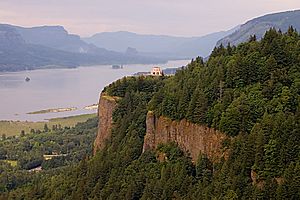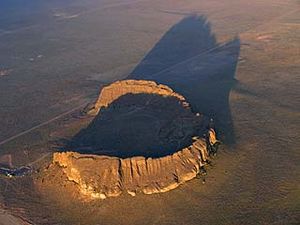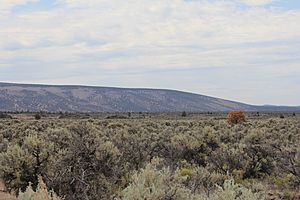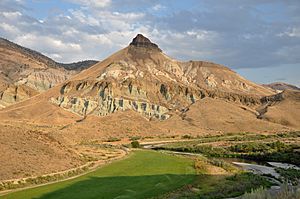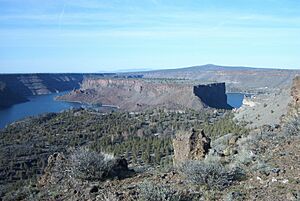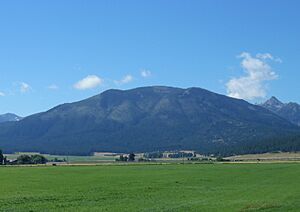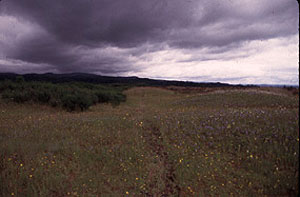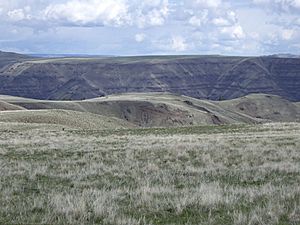List of National Natural Landmarks in Oregon facts for kids
Oregon is home to many amazing natural places, and some of the most special ones are called National Natural Landmarks. These are areas that show off the best examples of America's natural history. They might have unique rocks, special plants, or important animal habitats. Think of them like outdoor museums that help us understand our planet's past and protect its future.
Here are some of these incredible natural landmarks you can find in Oregon:
Contents
Crown Point
Crown Point is a beautiful spot in the Columbia River Gorge. It's a high cliff that sticks out, giving you amazing views of the Columbia River. From here, you can see the river winding through the gorge, surrounded by tall cliffs and green forests. It's a great place to learn about how rivers carve out landscapes over millions of years.
Fort Rock State Monument
Imagine a giant, circular wall made of rock in the middle of a flat desert. That's Fort Rock State Monument! This unique landmark is a volcanic tuff ring. This means it was formed when hot magma met water, causing a huge explosion that created a ring-shaped volcano. Over time, the softer parts eroded away, leaving behind this impressive rock formation that looks like an old fort.
Horse Ridge Natural Area
Horse Ridge Natural Area is a special place covered in Western juniper trees. It's a great example of a juniper woodland, which is a type of forest found in drier areas. This landmark helps us understand how these unique trees grow and how they fit into the desert landscape of Oregon. It's managed by the Bureau of Land Management, a government agency that looks after public lands.
John Day Fossil Beds
If you love fossils, then John Day Fossil Beds is the place for you! This area is famous for having an incredible collection of fossils from millions of years ago. Scientists have found fossils of ancient plants and animals, showing us what Oregon looked like long before humans were around. It's like a giant puzzle that helps us piece together the history of life on Earth.
The Island
The Island is a unique plateau that stands alone where the Deschutes and Crooked Rivers meet. It's covered in native juniper savanna, which is a grassland with scattered juniper trees. What makes it special is its isolated location, which has helped preserve its natural plant life. It's part of the Ochoco National Forest, a large area of protected land.
Lawrence Memorial Grassland Preserve
Lawrence Memorial Grassland Preserve is a private area that shows off a cool type of land called "biscuit and scabland" topography. This means the ground has small, rounded mounds (the "biscuits") and flat, rocky areas (the "scabland"). It's a great example of how different landforms are created by natural processes like erosion and volcanic activity.
Newberry Crater
Newberry Crater is a very interesting volcano in the Deschutes National Forest. It's a type of volcano called a shield volcano, but it's a bit unusual. Instead of a pointy top, it has a wide, flat shape with a huge crater in the middle. Inside the crater, you can find lakes and lava flows, showing how active this volcano once was. It's a fantastic place to learn about volcanoes and how they shape the land.
Mount Howard-East Peak
Mount Howard-East Peak is a mountain known for its amazing variety of plants. It has special mountain grasslands where many different kinds of plants grow, including some that are rare or found only in this area. This landmark helps protect these important plant species and their habitats, showing us the rich plant life of Oregon's mountains.
Round Top Butte
Round Top Butte is another important area for native plants. It has an "exceptional" habitat for bunchgrass, which is a type of grass that grows in clumps. These grasslands are very important for many animals and help keep the ecosystem healthy. This landmark is located on land managed by the Bureau of Land Management.
Willamette Floodplain
The Willamette Floodplain is a large, flat area along the Willamette River. It's a bottomland interior valley grassland, meaning it's a grassy area in a low valley that can sometimes flood. This area is part of the William L. Finley National Wildlife Refuge, which means it's a safe home for many birds and other wildlife. It's a great example of a river ecosystem and how important floodplains are for nature.
Zumwalt Prairie
Zumwalt Prairie is truly special because it's the largest unbroken area of bunchgrass prairie left in the entire country! This vast grassland is a vital habitat for many animals, including birds of prey and elk. It helps us understand what much of the American West looked like before it was settled and why it's so important to protect these natural spaces.


